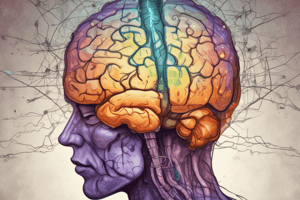Podcast
Questions and Answers
What is the most common cause of Traumatic Brain Injury (TBI)?
What is the most common cause of Traumatic Brain Injury (TBI)?
- Gunshot Wound
- Motor Vehicle Accident (MVA) (correct)
- Stab Wound
- Falls
Cerebral Edema leads to increased intracranial pressure (ICP).
Cerebral Edema leads to increased intracranial pressure (ICP).
True (A)
Which of the following is a risk factor for traumatic brain injury?
Which of the following is a risk factor for traumatic brain injury?
- Alcohol Intake (correct)
- Regular Physical Exercise
- Healthy Lifestyle
- High Socio-Economic Level
What does the acronym 'GCS' stand for?
What does the acronym 'GCS' stand for?
What is the Glasgow Coma Scale score range for a Moderate Head Injury?
What is the Glasgow Coma Scale score range for a Moderate Head Injury?
A persistent vegetative state means the patient has regained consciousness.
A persistent vegetative state means the patient has regained consciousness.
Identify one characteristic that defines a mild traumatic brain injury.
Identify one characteristic that defines a mild traumatic brain injury.
The compensatory mechanism in Traumatic Brain Injury fails if there is an increase in _____ and a decrease in blood supply.
The compensatory mechanism in Traumatic Brain Injury fails if there is an increase in _____ and a decrease in blood supply.
Which of the following is NOT a type of response to traumatic brain injury (TBI)?
Which of the following is NOT a type of response to traumatic brain injury (TBI)?
Study Notes
Traumatic Brain Injury (TBI) Overview
- Traumatic Brain Injury leads to an inflammatory response causing increased intracranial pressure (ICP) and cerebral edema.
- Increased ICP can reduce blood supply, worsening neural conditions.
Causes of TBI
- Motor Vehicle Accidents (MVA) are the most common cause of TBI.
- Other causes include falls and gunshot (GSW) or stab wounds (SW).
Risk Factors for TBI
- Alcohol intake.
- Low socio-economic status.
- Use of over-the-counter drugs, such as methamphetamine.
Responses to TBI
- Level of Consciousness: Initial assessment involves evaluating verbal and motor responses.
- Pupil reaction: Normal pupils should constrict and be equally reactive to light and accommodate.
- Doll's Eye Phenomenon: Indicates intracranial issues, where patient’s eyes are fixed at the center regardless of head movement.
Compensatory Mechanisms
- Increased production of cerebrospinal fluid (CSF) and shunting of blood to manage ICP.
- Failure of these mechanisms results in worsened conditions.
Classification of TBI Severity
- Mild Head Injury: Accounts for 80% of cases; no significant loss of consciousness, brief altered consciousness, no persistent neurological deficits. Glasgow Coma Scale (GCS) score of 13 or higher.
- Moderate Head Injury: 10% of cases; vague neuroanatomical lesions with GCS scores between 9-12. Possible post-traumatic experience lasting less than 24 hours.
- Severe Head Injury: GCS score of less than 8; coma lasting at least 6 hours but may recover consciousness, affects outcomes significantly.
- Persistent Vegetative State: Patient fails to regain consciousness, often resulting from severe TBI.
Coma Duration and Outcomes
- The longer the coma duration, the poorer the outcomes. A GCS score under 8 typically indicates severe impairment needing long-term management.
- Discharge might occur within 48 hours for mild cases with no significant findings on neurodiagnostic tests like EEG, CT scans, or skull radiographs.
Timing and Memory
- Mild TBI is characterized by short post-traumatic amnesia, defined as a brief period before the individual resumes normal memory functions.
Studying That Suits You
Use AI to generate personalized quizzes and flashcards to suit your learning preferences.
Description
This quiz provides an overview of Traumatic Brain Injury (TBI), covering its causes, risk factors, and responses. Learn about the physiological mechanisms involved and how they affect levels of consciousness and pupil reactions.




